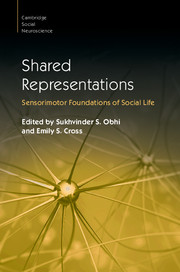Book contents
- Shared Representations
- Cambridge Social Neuroscience
- Shared Representations
- Copyright page
- Contents
- Figures
- Tables
- Boxes
- Contributors
- Preface
- Part I Foundations
- Part II Imitation and Mimicry
- Part III Thinking, Perceiving and Acting with Others
- Part IV Understanding Others
- 15 The Social Function of the Human Mirror System
- 16 Biological Tuning of Mirror Mechanisms
- 17 Representation of Self versus Others’ Actions
- 18 Reading Intention in Action
- 19 Complementary Actions
- 20 Emotional Convergence
- Part V Learning and Development
- Part VI Shared Representations in Applied Contexts
- Index
- Plate Section (PDF Only)
- References
16 - Biological Tuning of Mirror Mechanisms
Evidence and Functional Implications
from Part IV - Understanding Others
Published online by Cambridge University Press: 27 October 2016
- Shared Representations
- Cambridge Social Neuroscience
- Shared Representations
- Copyright page
- Contents
- Figures
- Tables
- Boxes
- Contributors
- Preface
- Part I Foundations
- Part II Imitation and Mimicry
- Part III Thinking, Perceiving and Acting with Others
- Part IV Understanding Others
- 15 The Social Function of the Human Mirror System
- 16 Biological Tuning of Mirror Mechanisms
- 17 Representation of Self versus Others’ Actions
- 18 Reading Intention in Action
- 19 Complementary Actions
- 20 Emotional Convergence
- Part V Learning and Development
- Part VI Shared Representations in Applied Contexts
- Index
- Plate Section (PDF Only)
- References
Summary
A range of behavioural and neuroimaging evidence demonstrates that we mirror observed human action in our motor systems to a greater extent than similar non-biological movement. This chapter reviews such evidence, considering the form and kinematic features of observed stimuli to which mirror mechanisms are sensitive. It subsequently considers the role of this biological tuning in our interactions with, and processing of, humans relative to inanimate devices, in the context of functions likely to be supported by mirror mechanisms. It notes that in contrast with common assumptions, biological tuning is unlikely to reflect increased inferential processing about mental states of observed humans. It considers that biological tuning is more likely to influence our imitation and perception of human and inanimate movements. The final section examines how biological tuning can be integrated with evidence that mirror mechanisms are part of a wider domain-general system adapted for action control, mapping motor codes onto observed events from both our social and inanimate environments.
- Type
- Chapter
- Information
- Shared RepresentationsSensorimotor Foundations of Social Life, pp. 332 - 350Publisher: Cambridge University PressPrint publication year: 2016

